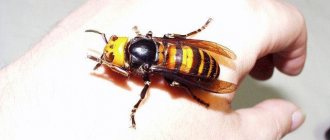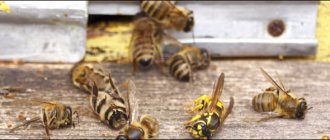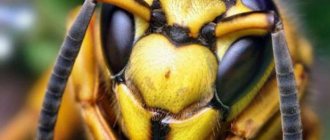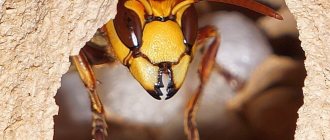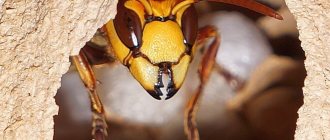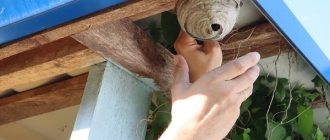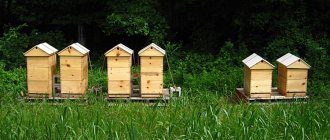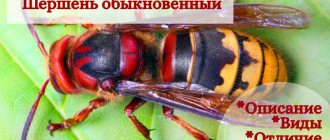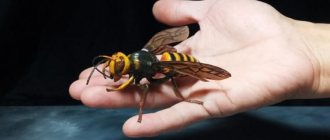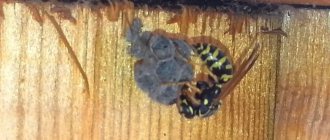Many people are accustomed to thinking that hornets only cause harm. However, hornets are natural predators that can significantly reduce the number of garden pests. They help rid the area of insects, but a person can be bitten by them, and the bite will have serious consequences. Hornet nests can often be found in attics, gazebos, verandas, that is, in close proximity to human habitation. It is important to know how to avoid such proximity and properly destroy nests.
The structure of a hornet's nest
Hornets can rightly be called real architects. The hive is created practically and thoughtfully. The nests are spherical or cone-shaped. The average size is 30 to 50 cm wide and 50 to 70 cm long. Sometimes you can find a large dwelling over 1 m. It usually weighs up to 1000 g.
The nest can be compared to a multi-story building, which has a huge number of apartments and several entrances. The rooms are honeycombs. The role of entrances is performed by compartments. There is a thin partition between the compartments.
The tiers are located in a perpendicular position. This is where the uterus moves. They are held together by several legs. One dwelling has 3 or 4 compartments. The number of tiers is from 7 to 10. The structure is neat and airy.
Hornets nest.
Choosing a drug to combat stings
Now there are a number of methods that make it possible to destroy the nest and its inhabitants.
But it is best to do this at night or at dusk:
- Drown the hive in a bucket of water/kerosene solution - this option does not necessarily require removing the cocoon. If the dwelling is located on top, the bucket should be raised to it, and then a ladder should be placed at the bottom. The hive should be in the liquid for several hours, preferably all day. After waiting the necessary time, you can clean the softened house.
- It is not so easy to ensure the removal of the nest if you treat it with an insecticidal aerosol, which is intended to destroy pests - popular products are such as Executioner, Get, Karbofos, Lambda Zone. Buy 2-3 bottles at once. Spray the entire internal cavity through the inlet holes, then move away as far as possible and do not touch the cocoon for several days. This period will be enough to destroy those individuals that were inside and those that arrived after treatment. At the end of the procedure, burn their house.
- Treating the nest with fire extinguisher foam - try to wet each cell - in such cases, each resident will freeze, after which you can tear off the hive at the base and destroy it.
- Nests that hang in the wind of a tree can be burned by first dousing it with kerosene or gasoline, but here you need to be especially careful to avoid the risk of a fire.
- When settling hornets inside a hollow that has a narrow entrance, pour one of the strong chemicals into it, and then quickly seal the gap.
- Reliable extermination of the nest and colony is possible using a large plastic bag, which is pre-treated with an insecticidal preparation. It is used to cover or wrap a cocoon - an excellent option when the nest is located inside a house/apartment.
- Blocking the entrances to the socket using polyurethane foam.
- When placing the family inside a hole underground, you can use boiling water and make a fire, digging up the entrance holes a little.
- Underground housing can be filled with kerosene and then set on fire.
Each of the above methods must be used in the evening or at night - with minimal activity of predators. Despite the fact that many people believe that hornets sleep at night, this is not the case - they can rest or do other things. Use a flashlight during this procedure with caution, since the insect will immediately react to changes in lighting.
How to detect a hornet's nest
Insects are not capable of causing harm to humans unless touched. They do not destroy or destroy hives located in a natural area and away from people. The hornet is an inhabitant of the wild and performs its function.
However, when settling near a person, you need to be vigilant. Such neighbors are very dangerous.
- Insect infestations pose a mortal danger to bees. This threatens the destruction of apiaries. Hornets destroy larvae and adults, and also consume honey.
- The search for the hive begins at the initial stage of formation. The founder of the home is the queen. Thanks to the queen, the first tier is laid and eggs are laid in the honeycomb.
- Timely detection guarantees easy destruction. Within a few weeks, a large number of individuals appear, which are more difficult to control.
- The hornet prefers a quiet, secluded place that is protected. Such places can be holes, barns, attics, abandoned buildings, hollows in trees.
Search organization includes:
- carrying out training. Take antiallergic medications with you. Special protective thick clothing is required;
Hornet's nest.
- the study begins with an examination of all secluded places in the house. The nest can be found in a window frame, in a wall, or under the floor. These are the most inaccessible places;
- Conducting an inspection of the entire site. They explore holes, stumps, logs, trees;
- listening - insects make a lot of noise when building a home;
- insect mark - a bright thread or ribbon is attached to the caught hornet and its further flight is monitored.
How to get rid of it
Huge hornet nest.
After finding the hive, the degree of danger is determined. When located in a corner, do not touch the nest.
But if it is in an accessible place, then it is necessary to get rid of it. This is difficult and dangerous, as the insects defend themselves aggressively.
The most effective methods of elimination include:
- treatment with insecticides;
- burning;
- pouring boiling water;
- heating.
The methods can be called cruel and risky. They are used as a last resort.
Equipment and first aid
Hornets have a long and sharp sting that can pierce even thick denim fabric. A person planning to approach the nest should protect himself by wearing a protective suit. These are what beekeepers wear when they pump out honey. Cover your face with a helmet with a net.
You will need thick, long gloves, because a person allergic to hornet venom only needs one bite to cause Quincke's edema or anaphylactic shock. What to do if there is no special suit? Put on several pants, a thick jacket and a sweater, wrap your neck with a thick scarf, without leaving even small gaps. Find an old hat and attach a piece of curtain to it, turning it into a makeshift protective helmet.
Wear rubber boots or high winter boots on your feet. No flip flops or sandals. The pants are tucked into socks and then into boots so that predatory insects do not have access to the body.
Before starting the operation, consider retreat options. Perhaps place a barrel or iron bathtub filled with water in the yard. A person attacked by hornets will be able to jump into a container of liquid and hide for 30–40 seconds. This is often enough for the angry guards to retreat.
A person who has been stung by a hornet needs first aid. Act quickly to stop the poison from spreading throughout the body, so have the following on hand:
- a bottle of peroxide, ammonia or calendula tincture;
- packaging of an antihistamine, such as “Suprastin” or “Diazolin”;
- roll of cotton wool;
- a bowl of ice wrapped in cloth.
A cotton swab soaked in an alcohol-containing solution is applied to the bite, and the victim is given an antihistamine tablet to prevent anaphylactic shock. Ice is then applied to the swollen soft tissue to stop the swelling from spreading.
Number of individuals living in one nest
The number of insects is influenced by a comfortable location, weather conditions, and food. The number of adults in one family ranges from 400 to 600.
Optimal conditions are calm, quiet, warm places with plenty of food. In this case, the diameter of the nest exceeds 1 m and accommodates from 1000 to 2000 individuals.
Hornets nests.
Ensuring security measures
When determining a method of dealing with a hornet's nest, you first need to take care of your own protection from pests. The most suitable option in this case is a beekeeper’s mask, closed clothing, and gloves made of thick fabric.
If the wasp family's refuge has a complex configuration, rapid processing is not possible. If you see an insect, then immediately leave the place, but do not make sudden movements.
Nest construction
Device
The hive is always durable and comfortable. It is not afraid of heat and cold. Insects build homes from wood and bark. Particular preference is given to birch. In this regard, the hives are lighter than those of other wasps.
Materials
The hornet thoroughly chews the wooden pieces, moistening them with saliva. The resulting material is the basis of honeycombs, walls, partitions, and shells.
Place
The choice of location depends on the uterus. It is from here that the construction of the future house begins. She prefers remote places, peace and solitude.
Process
Initially, the first ball is sculpted from the cells. Eggs are laid in the cells. After 7 days, larvae appear, which after 14 days turn into pupae. After another 14 days, young working insects leave the house and also participate in construction.
Peculiarities
Individuals are very hardworking and disciplined. Their self-organization is at a very high level. More productive work of young hornets affects the number of individuals. When the worker insects leave the hive, eggs are laid.
Methods of destruction
The presented insects use nests seasonally (only in spring, summer, autumn). After this, they leave them, most of them die, and the fertilized females try to hide in secluded places (hollow, under the bark of wood). With the onset of cold weather, they enter a process of diapause, which continues into the spring season.
The process of removing a house along with its inhabitants is very difficult, since they diligently guard the place of residence and, if necessary, will attack people, causing them pain and unpredictable consequences after bites.
Because of this, you need to consider and take safety measures:
- The use of clothing made of dense material should have long sleeves, and the cuffs should fit snugly to the skin;
- Covering your head with a thick hat; it is best to choose protective helmets with mesh;
- Feet must be protected with boots, hands with gloves;
- Wear safety glasses/mask on your face;
- The ideal option in such cases is a special beekeeper suit;
- Make sure to prepare a disinfectant and anti-allergenic agent in case of a bite;
- Think over an escape plan in advance if the swarm follows you - a pond or an enclosed space is suitable here;
- If children or people suffering from allergic reactions live on the premises, they should be temporarily relocated to a safe place.
Insects flying out of the hive
During autumn the house becomes empty. This is influenced by a number of nuances:
- after the start of swarming, males die very quickly;
- cold and frost kill worker hornets and the queen, and fertilized individuals move to warm places;
- in the fall, the female produces a special enzyme that prevents her from freezing in a state of suspended animation in winter;
- choose a temporary home - a hollow, a tree, an outbuilding;
- The hornet does not settle in an old nest; the construction of a new house always begins.
Glue-based trap, dummy
You can purchase a glue trap or make it yourself. To do this, you will need cardboard and special glue, for example, RaTrap or Alt. The paper sheet must be lubricated with adhesive. The layer should not be too thin, but not too thick. In order for the insects to fall into the trap, you need to put bait in the middle . Suitable for this:
- meat;
- fish;
- rotten fruit.
Such a trap has the following operating principle: hornets fly towards a treat, land on the cardboard and stick to its surface. They cannot free themselves and die. When the paper is filled with pests, all you have to do is throw it away. If you want to remove a hornet nest from the attic in the fall or at other times of the year, you can place several similar cardboard boxes there. This will allow you to quickly get rid of hated pests.
Now you can find special dummies of nests on sale. If placed in the attic, they will repel insects that do not settle nearby another swarm.
In addition, one of the enemies of hornets is the bat, so it is quite possible to use repellent devices that emit ultrasound and repel pests.
